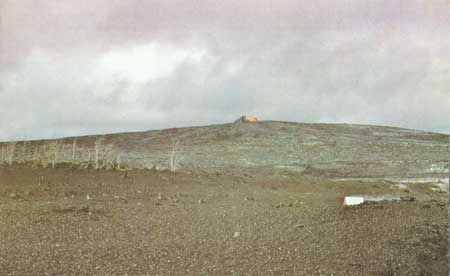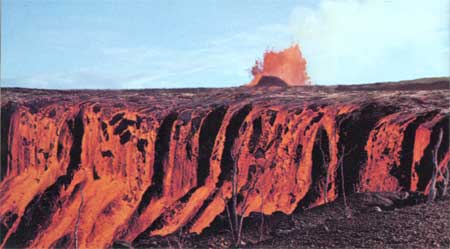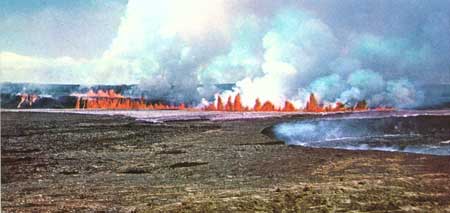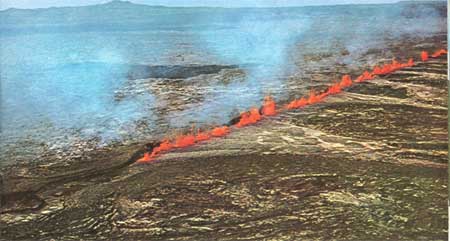|
HAWAI'I VOLCANOES & HALEAKALA Volcanoes of the National Parks of Hawaii |

|
KILAUEA, HOME OF PELE, THE FIRE GODDESS
(continued)
Drilling into the lava lakes. The pools of lava formed in Kilauea Iki, Alae, and Makaopuhi Craters during recent eruptions provided unusually good situations for studies of the cooling process of basalt lava. Holes were drilled into the crust of the Kilauea Iki lake by the Geological Survey in the spring of 1960; and on July 25, 7 months after the end of the eruption, a hole drilled cooperatively by the University of Hawaii and the Lawrence Radiation Laboratory of the University of California penetrated the crust and entered the liquid lava beneath it. The crust was found to be about 19-1/2 feet thick, and the temperature at its base about 1064° C. Later holes drilled by the Geological Survey followed the progress of thickening of the crust, which was shown to have increased to 35 feet by October 1961, and to 100 feet by 1967. The rate of cooling and thickening of the crust was approximately confirmed in drill-hole studies by the Geological Survey in Alae Lake (Peck, Moore, and Kojima, 1965), and in the Makaopuhi lake. In each case the thickness of the crust grew to about 19 feet in 6 months, with a temperature at its base close to 1067° C. Other measurements indicate a maximum temperature in the pool of liquid lava beneath the crust of about 1140° C (2084° F). Information is also being obtained on the sequence and temperatures of formation of different minerals in the cooling liquid lava, the changing composition of the part that remains liquid as crystals form in it, the viscosity of the liquid, and the heat conductivity of both the liquid and the solid crust. For the first time in history we are getting direct evidence and measurements on the complete cooling history of rock magmas in their natural environment.

PLATE 18. Dome fountain, about 4 feet high, at one of the Mauna
Ulu vents in June 1969. USGS photo by John C. Forbes
Halemaumau eruption of 1967-68. Through 1966 and most of 1967 Kilauea Volcano continued to swell, For the most part the rate of swelling was slow, but during October, 1967, rapid swelling caused an area southeast of Halemaumau to rise nearly 0.4 foot.
About 1:30 a.m. on November 5 volcanic tremor started to record on the Volcano Observatory seismographs, and at about 2:30 lava broke out in Halemaumau. Fountains 50 to 60 feet high formed a north-south line across the crater floor, and lava poured from them at a rate of more than 1.5 million cubic yards per hour. During the afternoon the fountains occasionally reached heights of 200 feet, and by midnight the pool of new lava was more than 100 feet deep, but the strength of the activity was decreasing. At 1 a.m. on November 6 eruption stopped, and the molten lava started to pour back into the vent. By mid-afternoon the surface of the lava in the center of the crater had lowered 45 feet, but around the edges a narrow ledge remained at the earlier high level.
Weak activity resumed on the morning of November 9 and gradually increased over the next several days, with intermittent jets of lava being thrown to heights of 50 to 100 feet. Tremor, which had never entirely ceased, gradually became stronger as greater volumes of lava moved upward. A lava lake was formed that covered about 40 percent of the crater floor, and around the edges of the lake a levee was built that held the lake surface 20 to 30 feet above the surrounding floor. Occasional overflows sent tongues of lava over the floor outside the levee. By November 19 the lake surface was 110 feet above the pre-eruption floor of the crater; but at 7:45 p.m. activity again stopped, and by noon on November 20 drainback had lowered the lake surface 20 feet.

PLATE 19. Aloi Crater overflowing on April 9, 1970. In the
foreground pahoehoe lava is burning the exhibit case at the road. Puu
Huluhulu, a prehistoric cinder- and-spatter cone, is in the
background. USGS photo by John C. Forbes
Activity began again at 3:30 a.m. on November 21, and fountains 50 to 100 feet high quickly refilled the lake basin with lava. This pattern of alternation of a period of active fountains and lava lake, followed by a period of inactivity and drainback continued through 28 successive phases, with the level of the lake surface showing a continual net rise and overflows building up the surrounding crater floor (figure 7C).
The advent of the 29th eruptive phase, on February 27, 1968, brought a change in the pattern of the eruption. Overflows of the lake onto the surrounding crater floor became much less frequent, but the lava lake activity became continuous and both the lake surface and the surrounding crater floor continued to rise as a unit, pushed upward from beneath, at an average rate of more than a foot a day. Lava fountains near the northeast edge of the lake built a group of steep-sided symmetrical spatter cones, the highest of them about 50 feet high. By early July the lake surface was only about 100 feet below the rim of Halemaumau Crater, but on July 8 activity ceased and the lava in the lake drained back into the underlying fissures, leaving an empty basin 40 feet deep. On July 13 lava again trickled into the lake basin, forming a small pool a few feet deep, but this continued for only a few hours. The eruption in Halemaumau was over, but activity soon shifted to the nearby Chain of Craters, on the upper part of the east rift zone.

PLATE 20. The shield volcano built by the eruption of 1969-70,
as it appeared on, June 3, 1970, from the Chain of Craters Road. Glow
can be seen in the spatter cone at the summit of the shield. USGS
photo by John C. Forbes
Eruptions of 1968-71. Early on August 22, 1968, an outbreak took place on a fissure that opened across Hiiaka Crater (Figure 8), and lava quickly formed a pool 300 feet across and 100 feet deep in the bottom of the crater. At about the same time another outbreak formed a small lava flow about a mile farther east. The eruption lasted only a few hours. however, and by noon drainback had removed most of the lava from Hiiaka Crater, leaving only a thin veneer over the crater bottom. During the eruption the summit of Kilauea sank more than 6 inches. but within about 3 days the volcano had started to swell again, and on October 7 lava broke out of a series of fissures that extended from Kane Nui o Hamo east-northeastward for three miles. New lava covered a large part of the flows of March 1965, and again spilled into Napau Crater. Activity continued until October 21.
On February 22, 1969, a brief eruption took place along a line of fissures between Alae and Napau Craters. Lava poured into Alae and Makaopuhi Craters, and buried 3 miles of the Chain of Craters Road, before activity came to an end on February 27.
On May 24 lava fountains broke out along a fissure that extended from a point just southwest of Aloi Crater to Kane Nui o Hamo, and lava again cascaded into Alae Crater and covered part of the Chain of Craters Road. The activity ceased on May 25, but began again on May 27 at a point 0.2 mile northeast of Aloi Crater. This was the beginning of a period of activity that lasted, with interruptions, until July 1974.
Records of eruptions since 1965 are still not completely published, and much of the following account is abstracted from unpublished data of the U.S. Geological Survey's Hawaiian Volcano Observatory, through the courtesy of the Observatory staff.

PLATE 21. Lava cascading into Aloi Crater on December 30,
1969. The lava fountain and cone at Mauna Ula are in the background.
NPS photo by D. W. Reeser
For the most part, the eruption has consisted of a series of brief periods of strong activity, most of them lasting only a few hours, with intervening periods of days or weeks of relative quiet. During periods of lesser activity the lava level commonly fluctuated rapidly within the vent, rising 100 feet or more in 30 to 60 minutes, then falling an equal amount in 5 minutes or less. When the general lava level was high these rises resulted in overflow. For instance, between July 20 and 31, 1969, lava repeatedly rose to the surface and flooded over the crater rim, forming short flows, or a pool 30 to 50 feet wide around the vent, only to drain back abruptly to a depth of 150 feet. The whole cycle was repeated at 15 to 20 minute intervals.
Periods of strong activity have been marked by voluminous lava discharge, and commonly by fountains 50 to 200 feet high. On September 6, 1969, the fountain reached a height of 1,800 feet. During smaller overflows the fountain sometimes had the usual jet-like form, but during others it took the form of a dome-shaped upwelling as much as 30 feet high over the vent, resembling the dome of water that often forms over a flowing artesian well (Plate 18).
The repeated overflows, together with accumulation of spatter and cinder from the fountains, built a gently sloping shield-shaped cone (Plate 20) more than a mile across and about 400 feet high, called Mauna Ulu. Similar prehistoric shield volcanoes along the rift zones of Kilauea, such as Kane Nui o Hamo (Figure 8) and Heiheiahulu, must have been built in much the same manner.
Flows from Mauna Ulu have filled both Alae and Aloi Craters (Plates 19 and 21). During much of the eruption, vents have existed along the eruptive fissure that extends down the east-northeast side of the cone. Collapses along the fissure have formed small pit craters or an elongated trench, Some lava flows from these vents spread northward into the forest. Others moved southeastward and eastward, some of them cascading into Makaopuhi Crater (Figure 8).
Lava overflowing or draining through tubes from Alae Crater moved southeastward, and several flows formed spectacular cascades over the palis (cliffs) near the south coast, spreading out to form pools on the coastal flat. On June 25, 1969, one of these reached the shore and poured a few tens of cubic yards of lava into the ocean. Another flow reached the shore on September 25, 1970, entering the water over a front 2,000 feet broad, but the flow continued for only another day. On February 22, 1971, lava again flowed over the southern palis and started to spread out on the coastal flat. In early March it buried the old Hawaiian village site of Kealakomo, and on March 8 it reached the ocean with a front several hundred yards wide. Lava continued to enter the ocean until May 14, building about 97 acres of new land. Divers were able to observe the behavior of the lava beneath the water, including the development of "pillow" lava (rounded lava masses characteristic of eruption in water), the actual formation of which had never before been seen.

PLATE 22. Lava fountains on the floor and east rim of Kilauea
Caldera, Halemaumau Crater on the right, August 14. 1971. Lava is
cascading from the caldera rim onto the floor. USGS photo by John C.
Forbes.
From April 2 to July 20, 1971, the activity at Mauna Ulu gradually declined, and by mid-July the level of the lava lake in the summit crater was more than 300 feet below the crater rim. Circulation in the lake was slugglish. But, despite the decrease in activity at Mauna Ulu, inflation of the summit area of Kilauea not only remained great, but increased. Shallow earthquakes from sources near the caldera also increased, suggesting a shift in the scene of volcanic activity.
On August 14, 1971, fissures opened across the floor of Kilauea Caldera from a point about 700 feet east of the Halemaumau parking lot eastward to the caldera rim just north of Keanakakoi Crater (Figure 4B). Fountains as much as 250 feet high played along the fissures, and cascades of lava poured down the caldera wall to join lava poured out of the fissures on the caldera floor (Plate 22). A flow of pahoehoe advanced northward to the foot of the northern caldera wall, below the Volcano House. Lava discharge on the caldera rim lasted for less than 2 hours, but on the caldera floor eruption continued, gradually abating, for 10 hours. About one-fifth of the caldera floor was covered with new lava.
The August eruption was followed by a brief period of quiet, but then seismic activity again increased and by mid-September was at a high level. At 7:20 p.m. on September 24 a fissure opened across the southwestern part of the Kilauea caldera floor, soon lengthening across Halemaumau and 800 feet beyond. Fountains as much as 150 feet high played along the entire length of the fissure, while lava cascaded into Halemaumau and spread southward across the Crater Rim Road. About 8 p.m. cracks started to open across the rim of the caldera and southwestward down the rift zone, and lava fountained from them, forming a cascade down the southwestern caldera wall. This was the beginning of a series of outbreaks along the rift zone during the next two days. Each was brief, and although the outflow of lava was voluminous, the fountains were low (Plate 23). At 6:30 a.m. on September 26 an outbreak occurred on the southwest flank of Mauna Iki, a satellitic shield volcano that had been formed in 1920, and at 10:12 another took place on the northeast flank, followed in the afternoon by two others about one and two miles farther northeast (Figure 8). As the activity worked back up slope the more southwesterly vents died out. Weak spattering continued until late on September 29. During the eruption the floor of Halemaumau sank, leaving a circular bench veneered with new lava surrounding a central pit 150 feet deep.
Through the last quarter of 1971 the vent at Mauna Ulu continued to fume. During October sounds of splashing lava could be heard from invisible depths in the vent, but in November and December no signs of lava activity could be detected. However, inflation of the Kilauea summit region continued.

PLATE 23. Row of lava fountains and flows on the southwest
rift zone of Kilauea, September 25, 1971 — a good example of a
fissure eruption. NPS photo by Bryan Harry